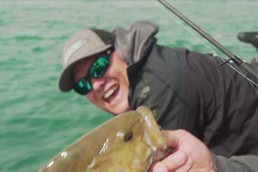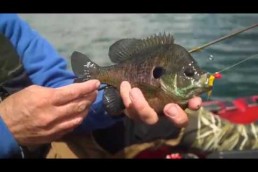Small Boats for More and Bigger Pond Bass
SHARE THIS POST
Most average anglers view fishing a farm pond or small impoundment as a piece of cake. The logic here is that there’s not much water, so it’s not that tough. These fishermen usually catch an average number of fish, ones with average size, from a pond. But being able to read the habitat and conditions and have the mobility of a boat can increase your chances for better-than-average-sized fish.
We shouldn’t let pond size influence our decision to use a boat. Obviously, we don’t want to put a 20-foot bass boat on 2 acres of water. But 12- or 14-foot jon boats, canoes or small plastic two-man boats are perfect because these are small, light and easy to handle. On bigger ponds, I like an electric trolling motor, but on smaller ponds I prefer to paddle.
The main advantage to fishing a pond from a boat is to be able to cast to places that are too difficult to reach from the shore. Also, fish tend to rest and feed in the shade from trees on a bank. These spots are sometimes hard to hit when trying a parallel-bank-casting method. A boat also allows you to find deep spots for vertical jig-type fishing.
With a boat you can also approach structure from a much better vantage point. For example, a tree has been blown over and lies in the water. By boat, you can make parallel casts along both side and fish the ends of that tree. Chances are that the end of the tree is closer to deeper water than the sides.
Points and fingers should be studied and approached in a similar fashion. These are not impossible to fish from shore, but they are certainly more accessible from a boat, especially for panfishermen. Often, crappies and bluegills congregate in places that make casting a real challenge. A boat can literally put you right on top of these hideouts. And if structure is brushy this can save you lots of fish and hooks.
During times when fish are seeking deeper, warmer and more oxygenated water, bank fishing can be very frustrating. Finding an artificial bait that will stay in these deep strike zones long enough to be effective is difficult. Because bank casting forces a crankbait or spinnerbait to run from deep to shallow water, they actually run out of the strike zone very quickly. Conversely, from a boat, the baits run into and stay in the strike zone longer, producing more strikes and more fish.
Are you enjoying this post?
You can be among the first to get the latest info on where to go, what to use and how to use it!
Many anglers come to farm ponds and small impoundments with only one thing in mind: catfish. Boats can also be very handy for those who prefer chasing this species. The ability to cover more area and focus on high-density feeding areas can really improve your odds of finding and staying with the catfish.
For the boat itself, there are a couple of minor things you can do to a smaller craft to improve its performance. Keeping in mind how large a role noise plays on small bodies of water, soundproofing your boat can make a difference. Carpet remnants on the floors and seats will muffle a lot of noise of movement and dropped objects. A pair of needle-nosed pliers hitting the floor of an aluminum boat will alert every fish for miles and usually aggravate a otherwise agreeable fishing partner. Also, avoid oversized tackle boxes in small boats. Put together a small box just for pond fishing. Most of us cast no more than three lures on any given trip, so why take dozens?
A few years back, my son Caleb and I decided to make an after-work run to a great little 5-acre puddle in Adams County. We used a 12-foot jon boat and an electric motor. This rig was ideal for this body of water because there are brush piles in the middle of the pond. The cover not only held lots of fish, but lots of lures, and most were donated by bank fishermen with poorly aimed casts. We got on the water about 6:30 p.m. and headed straight for the structure. We decided to move in slowly and quietly and fish the outer edges of the brush first. This plan would not have been possible without a small boat.
My white spinnerbait and Caleb’s chartreuse one hit the water simulatneously. Caleb ran his down about 4 feet while I let mine go all the way to the bottom. I bumped every piece of brush I could feel. This limb-bumping method produced the first bass. Not a big fish, but it helped to set the pattern.
After about 20 minutes and three more deep bass, Caleb began to let his bait work closer to the cover. He soon caught up to me in number of bass taken and even plowed me under with a nice 6 1/2-pounder.
Because the baits “found” and chosen were productive that day and because of our effective presentation, we both decided we would have been severely handicapped without the smaller boat. Little boats on little bodies of water are not only handy, but also make a trip more fun.
MWO
SHARE THIS POST
Did you enjoy this post?
You can be among the first to get the latest info on where to go, what to use and how to use it!
Mike Roux
Mike Roux is an award-winning outdoor writer. He is a former Illinois Outdoor Writer of the Year. Roux is also a renowned speaker available to sportsmen’s groups as well as youth and church groups. Check him out at mikeroux.com.



